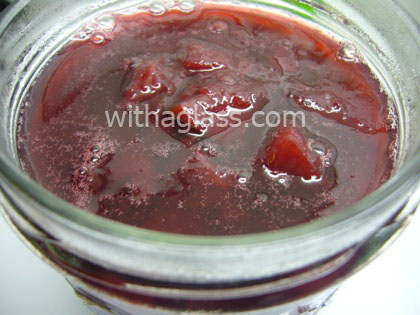Nectavigne Jam

Remember the vineyard peach? Nectavigne is its young and beautiful cousin. This French cross between the vineyard peach and the nectarine exists on the market only since 2004 and I hope it will stay for good! I usually am not fond of the newly developed fruit or vegetable varieties, as they tend to be rather good looking than good tasting, the main interest being easy, fast and cheap growing process. I find however the nectavigne simply enchanting! Maybe it is an easily grown fruit, but it certainly is also delicious and very aromatic. I am only worried it’s so rarely seen on the markets…
Like the vineyard peach, nectavigne takes on a darker, beetrooty colour during the cooking process and it looks very originally among other jars. The jam is made more or less in the same way as the peach jam I posted a while ago, but the peeling stage is omitted and since the nectavignes are harder than the peaches, I prefer dividing the cooking time in two days.

Special equipment: wear rubber gloves while manipulating the fruit (it stains the nails for a couple of days)
Preparation: around 1 hour +jars processing
Ingredients:
1 kg stoned nectavignes
300g sugar (or more if the fruit is not very ripe)
juice from 1 lemon
40g pectin in powder (or less if you prefer a runny jam)
Cut the fruit into small pieces (do not throw away the juice!).
Put the fruit, the lemon juice and a couple of tablespoons of water into a non reactive pan and cook 20 minutes on a rather high heat until the nectavignes become soft. Stir it often and watch the pan constantly (if there is not enough liquid they will burn). Add the lemon juice, the sugar, let it dissolve, cover and put away for the night.
The following day cook the nectavignes for 20 more minutes.
Add the pectin and more sugar if the jam is not sweet enough, stir it and cook for another ten minutes. Put aside.
Spoon hot jam into sterilised jars, cover with lids.
Leave the jars to cool.
Place the cool jars into a big pan, bottom lined with an old kitchen towel folded in two (this will prevent the jars from breaking), cover up with hot – but not boiling- water to the level just below the lid. Bring to boil and keep on a very low heat, in simmering water, for around 20 minutes.
Stick on self-adhesive labels, write the name of the jam and don’t forget to mark the date.